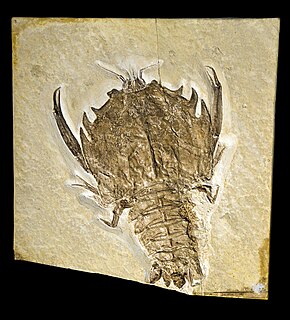 W
WAntrimpos is an extinct genus of crustacean which existed during the Triassic and Jurassic periods. It contains 15 species, including Antrimpos speciosus.
 W
WCyclida is an order of fossil arthropods that lived from the Carboniferous to the Cretaceous. Their classification is uncertain, but they are generally treated as a group of maxillopod crustaceans.
 W
WColeia is an extinct genus of decapods in the group Polychelida that lived from the Late Triassic to the Late Jurassic. It was described by Broderip in 1835, and the type species is C. antiqua. A new species, C. martinlutheri, which existed during the Sinemurian of what is now Germany, was described by Günter Schweigert and Werner Ernst in 2012.
 W
WCyclida is an order of fossil arthropods that lived from the Carboniferous to the Cretaceous. Their classification is uncertain, but they are generally treated as a group of maxillopod crustaceans.
 W
WErymidae is a family of decapod crustaceans known only from fossils. They survived for 100 million years, from the Permo-Triassic boundary to the Hauterivian. Eleven genera are recognised:Clytiella Glaessner, 1931 – 1 species Clytiopsis Bill, 1914 – 3 species Enoploclytia M’Coy, 1849 – 20 species Eryma Von Meyer, 1840 – 44 species Galicia Garassino & Krobicki, 2002 – 3 species Lissocardia Von Meyer, 1851 – 3 species Palaeastacus Bell, 1850 – 24 species Paraclytiopsis Oravec, 1962 – 1 species Protoclytiopsis Birshtein, 1958 – 1 species Pustulina Quenstedt, 1857 – 12 species Stenodactylina Beurlen, 1928 – 1 species
 W
WEryonidae is a family of fossil decapod crustaceans which lived from the Upper Triassic to the Lower Cretaceous. It contains four genera: An aggregation of three unidentified eryonids was reported in 2012 inside a Late Jurassic ammonoid of the species Harpoceras falciferum; they represent the earliest evidence of gregarious behaviour in decapods.Cycleryon Glaessner, 1965 Eryon A. G. Desmarest, 1817 Knebelia Van Straelen, 1922 Rosenfeldia Garassino, Teruzzi & Dalla Vecchia, 1996
 W
WCyclida is an order of fossil arthropods that lived from the Carboniferous to the Cretaceous. Their classification is uncertain, but they are generally treated as a group of maxillopod crustaceans.
 W
WIfasya is an extinct genus of prawn. It contains the species Ifasya madagascariensis and Ifasya straelini, and was named in 1995 by Alessandro Garassino and Giorgio Teruzzi. It existed in Madagascar during the Lower Triassic period.
 W
WKazacharthra is an extinct order of branchiopod crustaceans that appear to be closely related to the living order Notostraca. Kazacharthrans lived in marshes and ponds in the Upper Triassic of Western China and Mongolia, and in Lower Jurassic Kazakhstan. It is presumed that the kazacharthrids lived much like their living relatives, in that they were opportunistic omnivores that fed on any available food source, from bacterial biofilms to detritus to smaller animals that could be overpowered.
 W
WLongichela orobica is an extinct species of prawn which lived in the Norian, and is the only species in the genus Longichela.
 W
WCyclida is an order of fossil arthropods that lived from the Carboniferous to the Cretaceous. Their classification is uncertain, but they are generally treated as a group of maxillopod crustaceans.
 W
WCyclida is an order of fossil arthropods that lived from the Carboniferous to the Cretaceous. Their classification is uncertain, but they are generally treated as a group of maxillopod crustaceans.
 W
WTriops longicaudatus is a freshwater crustacean of the order Notostraca, resembling a miniature horseshoe crab. It is characterized by an elongated, segmented body, a flattened shield-like brownish carapace covering two thirds of the thorax, and two long filaments on the abdomen. The genus name Triops comes from Ancient Greek ὤψ or ṓps, meaning "eye" prefixed with Latin tri-, "three", in reference to its three eyes. Longicaudatus is a Latin neologism combining longus ("long") and caudatus ("tailed"), referring to its long tail structures. Triops longicaudatus is found in freshwater ponds and pools, often in places where few higher forms of life can exist. Like its relative Triops cancriformis, the longtail tadpole shrimp is considered a living fossil because its basic prehistoric morphology has changed little in the last 70 million years, exactly matching their ancient fossils. Triops longicaudatus is one of the oldest animal species still in existence.